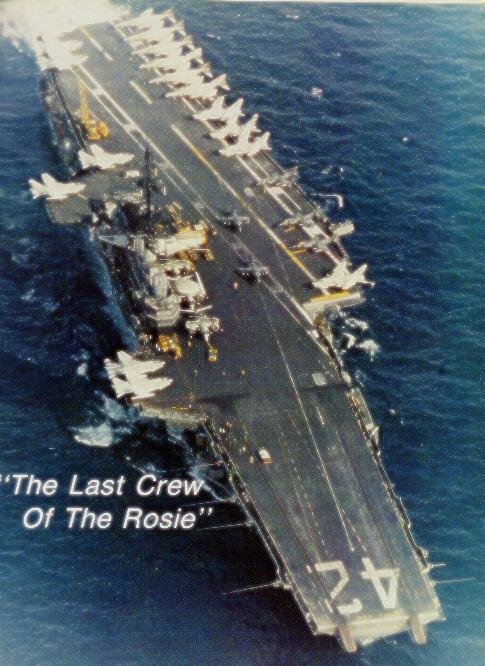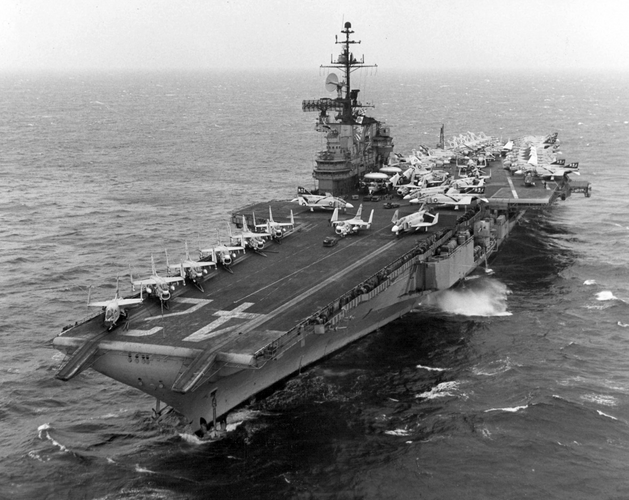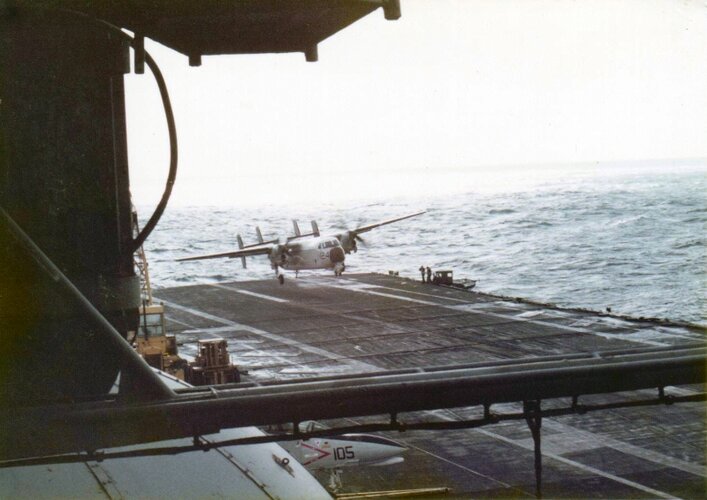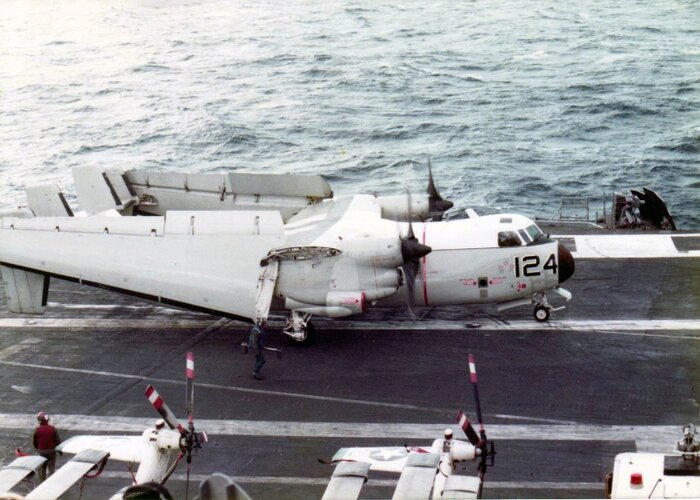1981 Hearings. Possible reactivation, not only of Oriskany but also of Bon homme Richard
You are using an out of date browser. It may not display this or other websites correctly.
You should upgrade or use an alternative browser.
You should upgrade or use an alternative browser.
Cold Warriors: The Essex Class in the Cold War
- Thread starter SSgtC
- Start date
SSgtC
ACCESS: Top Secret
- Joined
- 13 July 2020
- Messages
- 1,240
- Reaction score
- 2,877
Interesting read. I knew that Oriskany had been looked at pretty heavily for reactivation as part of Regan's 600 ship Navy, to the point that the Navy was willing to can the reactivation of all 4 Iowa class to get her, but I didn't know that they also wanted Bon Homme Richard recommisoned. It does give some interesting info on how they planned to refit them. Especially the part about putting steel decks and Hornets on them.1981 Hearings. Possible reactivation, not only of Oriskany but also of Bon homme Richard
Bon homme Richard had been the first of the SCB-27C (= C-11 steam catapult Essex) to be retired in 1971. So it had already spent a decade in storage. Wonder about the five other SCB-27C. Were these ships in poor shape ?
Wiki has a detailed list (as usual)

 en.wikipedia.org
en.wikipedia.org
Wiki has a detailed list (as usual)

SCB-27 - Wikipedia
| Ship | Program | Shipyard | Work Began | Recommissioned | Decommissioned |
|---|---|---|---|---|---|
| USS Oriskany (CV-34) | SCB-27 | New York | Aug 1947 | Sep 1950 | September 1976 |
| USS Essex (CV-9) | SCB-27A | Puget Sound | Feb 1949 | Jan 1951 | June 1969 |
| USS Wasp (CV-18) | SCB-27A | New York | May 1949 | Sep 1951 | July 1972 |
| USS Kearsarge (CV-33) | SCB-27A | Puget Sound | Feb 1950 | Feb 1952 | February 1970 |
| USS Lake Champlain (CV-39) | SCB-27A | Norfolk | Aug 1950 | Sep 1952 | May 1966 |
| USS Bennington (CV-20) | SCB-27A | New York | Dec 1950 | Nov 1952 | January 1970 |
| USS Yorktown (CV-10) | SCB-27A | Puget Sound | Mar 1951 | Feb 1953 | June 1970 |
| USS Randolph (CV-15) | SCB-27A | Newport News | June 1951 | Jul 1953 | February 1969 |
| USS Hornet (CV-12) | SCB-27A | New York | July 1951 | Sep 1953 | June 1970 |
| USS Hancock (CV-19) | SCB-27C | Puget Sound | Dec 1951 | Feb 1954 | January 1976 |
| USS Intrepid (CV-11) | SCB-27C | Newport News | Apr 1952 | Jun 1954 | Mar 1974 |
| USS Ticonderoga (CV-14) | SCB-27C | New York | Apr 1952 | Sep 1954 | September 1973 |
| USS Shangri-La (CV-38) | SCB-27C/125 | Puget Sound | Oct 1952 | Jan 1955 | July 1971 |
| USS Lexington (CV-16) | SCB-27C/125 | Puget Sound | Sep 1953 | Aug 1955 | November 1991 |
| USS Bon Homme Richard (CV-31) | SCB-27C/125 | Hunters Point | May 1953 | Sep 1955 | 2 July 1971 |
Last edited:
SSgtC
ACCESS: Top Secret
- Joined
- 13 July 2020
- Messages
- 1,240
- Reaction score
- 2,877
Well, Hancock was sold for scrap the day after she decommissioned in 1976. Intrepid was supposed to be scrapped, but then donated to become a museum in 82 (she was already on donation hold when this hearing was held). Ticonderoga was scraped in 74. Shangri-la was used as a parts hulk for Lexington starting in 82. And well, Lexington was still commissioned and serving as the Navy's dedicated training carrier.
SSgtC
ACCESS: Top Secret
- Joined
- 13 July 2020
- Messages
- 1,240
- Reaction score
- 2,877
"Worn out" applies to pretty much all of the Essex class by the mid 70s. The Navy rode them hard in Vietnam. As an example, BHR deployed for a combat tour in Southeast Asia 5 times between 1965 and 1970.A pity for Hancock, but maybe it was just worn out.
BlackBat242
OK, I changed my personal text ;)
- Joined
- 10 April 2013
- Messages
- 1,447
- Reaction score
- 4,146
Hancock got her SCB-125 from Apr 1956 - Nov 1956.Bon homme Richard had been the first of the SCB-27C (= C-11 steam catapult Essex) to be retired in 1971. So it had already spent a decade in storage. Wonder about the five other SCB-27C. Were these ships in poor shape ?
Wiki has a detailed list (as usual)

SCB-27 - Wikipedia
en.wikipedia.org
Ship Program Shipyard Work Began Recommissioned Decommissioned USS Oriskany (CV-34) SCB-27 New York Aug 1947 Sep 1950 September 1976 USS Essex (CV-9) SCB-27A Puget Sound Feb 1949 Jan 1951 June 1969 USS Wasp (CV-18) SCB-27A New York May 1949 Sep 1951 July 1972 USS Kearsarge (CV-33) SCB-27A Puget Sound Feb 1950 Feb 1952 February 1970 USS Lake Champlain (CV-39) SCB-27A Norfolk Aug 1950 Sep 1952 May 1966 USS Bennington (CV-20) SCB-27A New York Dec 1950 Nov 1952 January 1970 USS Yorktown (CV-10) SCB-27A Puget Sound Mar 1951 Feb 1953 June 1970 USS Randolph (CV-15) SCB-27A Newport News June 1951 Jul 1953 February 1969 USS Hornet (CV-12) SCB-27A New York July 1951 Sep 1953 June 1970 USS Hancock (CV-19) SCB-27C Puget Sound Dec 1951 Feb 1954 January 1976 USS Intrepid (CV-11) SCB-27C Newport News Apr 1952 Jun 1954 Mar 1974 USS Ticonderoga (CV-14) SCB-27C New York Apr 1952 Sep 1954 September 1973 USS Shangri-La (CV-38) SCB-27C/125 Puget Sound Oct 1952 Jan 1955 July 1971 USS Lexington (CV-16) SCB-27C/125 Puget Sound Sep 1953 Aug 1955 November 1991 USS Bon Homme Richard (CV-31) SCB-27C/125 Hunters Point May 1953 Sep 1955 2 July 1971
Ticonderoga got her SCB-125 from Aug 1956 - Mar 1957.
Intrepid got her SCB-125 from Sept 1956 - Apr 1957.
Oriskany also got a SCB-125A modernization (included all features of SCB-27C and SCB-125) from Jan 1957-Mar 1959.
The SCB-27A ships got their SCB-125 modernization between 1955 and 1957.
Last edited:
isayyo2
Lurker alert
- Joined
- 24 November 2011
- Messages
- 1,131
- Reaction score
- 2,314
1981 Hearings. Possible reactivation, not only of Oriskany but also of Bon homme Richard
Back up a page or two and you'll see Admiral Foley's ambition for a dedicated Indian Ocean fleet based out of Perth (Shades of Fifth Fleet some 15 years early). The conversation is somewhat sidetracked by utilizing Harrier equipped LPH/LHD's to supplement/replace CVs operating in the Indian Ocean, which Foley wholly disagrees with. The Navy's view that Harriers were far too limited leads well to activating both Oriskany and Bon Homme Richard to reach 15-16 CVs. Had the fortune of speaking with Bob Foley a few times before his passing in 2019; had some amazing stories. Great find @Archibald !Interesting read. I knew that Oriskany had been looked at pretty heavily for reactivation as part of Regan's 600 ship Navy, to the point that the Navy was willing to can the reactivation of all 4 Iowa class to get her, but I didn't know that they also wanted Bon Homme Richard recommisoned. It does give some interesting info on how they planned to refit them. Especially the part about putting steel decks and Hornets on them.
Some may have also read this USNI proceeding as well:
A Fifth Fleet being activated in the wake of the Indonesian skirmishes could be an interesting plot line for this TL. Perhaps Lake Champlain with her 125A refit gets a second life "Down Under" @SSgtC ?
Thank you for that, I hadn't noted the Indian Ocean connection. About LPH & Harriers: obviously USS Guam was tested as a makeshift SCS between 1972 and 1975. With Harriers. AV-8A performance wasn't very good, for sure. Then again, it was first generation Harrier, itself first operational VSTOL, ever.
F.L.
ACCESS: Top Secret
From what I've read, Guam completed the SCS tests on 1 July 1974. And the trials had begun in January 1972.About LPH & Harriers: obviously USS Guam was tested as a makeshift SCS between 1972 and 1975. With Harriers. AV-8A performance wasn't very good, for sure. Then again, it was first generation Harrier, itself first operational VSTOL, ever.
Sea Control Ship
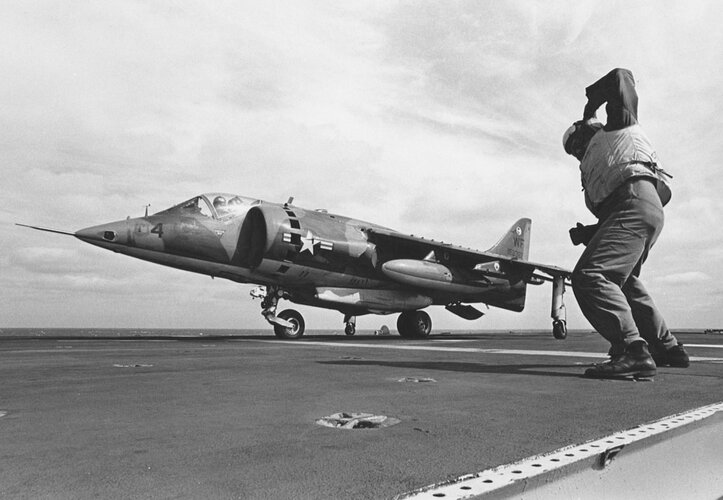

File:AV-8A VMA-513 taking off from USS Guam (LPH-9) 1972.jpeg - Wikimedia Commons
BlackBat242
OK, I changed my personal text ;)
- Joined
- 10 April 2013
- Messages
- 1,447
- Reaction score
- 4,146
Another first was racked up by USS FRANKLIN D. ROOSEVELT when, on 4 October 1976, the first overseas operational commitment on a carrier for the AV-8A Harrier began when VMA-231 embarked aboard for a Sixth Fleet deployment. On 13 January 1977, two other Harriers made bow-on approaches and landing aboard the carrier, marking the first time a fixed wing aircraft had made a bow-on, downwind landing aboard a carrier at sea.
October 4, 1976 - April 21, 1977; Mediterranean
Ports of call: Rota, Spain; Naples, Italy; Catania, Sicily, Italy; Taranto, Italy; Genoa, Italy; Monaco; Cannes, France; Barcelona, Spain
CVW-19 (tail code NM): VF-51 (F-4N); VF-111 (F-4N); VA-153 (A-7B); VA-215 (A-7B); VA-155 (A-7B); VMA-231 (AV-8A);
RVAW-110 Det. 4 (E-1B); VFP-63 Det. (RF-8G); HC-1 Det. 3 (SH-3G)
Franklin D. Roosevelt (CVB-42)
Franklin Delano Roosevelt (30 January 1882–12 April 1945), the 32nd President of the United States (4 March 1933–12 April 1945). (CVB-42: displacement 45,000; length 968'; beam 113'; extreme width 136'; draft 35'; speed 33 knots; compliment 4,104; armament 18 5-inch, 84 40-millimeter; aircraft...
The ship continued to write a chapter in the evolution of naval aviation. The first overseas operational commitment on a carrier for McDonnell Douglas AV-8As began when 14 Harriers of Marine Attack Squadron (VMA) 231, embarked with Franklin D. Roosevelt and CVW-19 as they set out for what became the ship’s final deployment on a voyage to the Mediterranean (4 October 1976–21 April 1977).
The ship and her wing resolutely continued to experiment with new ideas. A pair of AV-8As made a bow on approach downwind and landed on board Franklin D. Roosevelt on 13 January 1977. The Harriers landed with the other jets facing aft and demonstrated the capabilities of vertical and/or short take-off and landing (V/STOL) aircraft to land on carriers without many of the conditions necessary for fixed-wing, non-V/STOL aircraft. Throughout the cruise the Harriers validated that they could integrate and operate with predominantly fixed-wing air wings, though their exhaust damaged painted non-skid elements of the flight deck and blew some pieces off, creating a foreign object damage threat to aircraft.
If FDR had been given a full modernization (instead of her "austere overhaul") in 1969 to either SCB-110A as per CV-43 Coral Sea or to SCB-101.66 (preferably a slightly less-exaggerated version than Midway received) she could have served to at least the end of the 1980s, rather than being decommissioned on 1 October 1977 (and immediately stricken from the USN's books and sold for scrap on 1 April 1978, specifically to prevent her re-activation).
She could have operated F/A-18s & A-6s and E-2Cs just like her sisters did.
Last edited:
BlackBat242
OK, I changed my personal text ;)
- Joined
- 10 April 2013
- Messages
- 1,447
- Reaction score
- 4,146
F.L.
ACCESS: Top Secret
Is the long white line in front of the two AV-8s a special marking for Harriers ?Note the aircraft aboard:
...
BlackBat242
OK, I changed my personal text ;)
- Joined
- 10 April 2013
- Messages
- 1,447
- Reaction score
- 4,146
Yes... that is their take-off run marking, as no Harrier variant ever had catapult bridle/towbar or arresting hook fittings..Is the long white line in front of the two AV-8s a special marking for Harriers ?
When you think about it, FDR bane was: it was just big enough to be a CVV, kinda. That is: something the USN truly abhorred. Translation: "Congress: hey look, a carrier smaller than a Nimitz ! Must be cheaper !"
Neat thing with refurbished Essex class carriers: they were actually just too small to play a CVV role for Congress, against the Navy drive to get Nimitz - and only moar Nimitz, with additional Nimitz.
Bottom line: FDR was scrapped ASAP in 1978, when Oriskany (retired in 1976) and Bon Homme Richard (retired in 1971) almost staged a come back.
Neat thing with refurbished Essex class carriers: they were actually just too small to play a CVV role for Congress, against the Navy drive to get Nimitz - and only moar Nimitz, with additional Nimitz.
Bottom line: FDR was scrapped ASAP in 1978, when Oriskany (retired in 1976) and Bon Homme Richard (retired in 1971) almost staged a come back.
F.L.
ACCESS: Top Secret
This was to considerably complicate operations at the same time as the catapulted aircraft.Yes... that is their take-off run marking, as no Harrier variant ever had catapult bridle/towbar or arresting hook fittings..
The two catapults had to be cleared to launch a Harrier !
I'm surprised the AV-8s needed such a long length for a short takeoff.
The first generation Harriers performance really sucked. It is easy to forget it because "Harrier is a cool magical plane" and "AV-8A sounds like AV-8B" and also "Sea Harrier in the Falklands" (I'm guilty of that, in the first place).
But Harrier GR.3 and AV-8A performance badly sucked. Even early Skyhawks with J65 turbojets had more range and payload than any AV-8A in a good day. Not even mentionning A-7s.
The Spanish navy pilots really found a huge difference when they switched from "AV-8A on Dedalo" to "AV-8B on Asturias".
But Harrier GR.3 and AV-8A performance badly sucked. Even early Skyhawks with J65 turbojets had more range and payload than any AV-8A in a good day. Not even mentionning A-7s.
The Spanish navy pilots really found a huge difference when they switched from "AV-8A on Dedalo" to "AV-8B on Asturias".
Last edited:
F.L.
ACCESS: Top Secret
Harrier GR.3s have also been used successfully in Falkland."Sea Harrier in the Falklands"
But Harrier GR.3 and AV-8A performance badly sucked.
Franklin D. Roosevelt (CVB-42)
Franklin Delano Roosevelt (30 January 1882–12 April 1945), the 32nd President of the United States (4 March 1933–12 April 1945). (CVB-42: displacement 45,000; length 968'; beam 113'; extreme width 136'; draft 35'; speed 33 knots; compliment 4,104; armament 18 5-inch, 84 40-millimeter; aircraft...www.history.navy.mil
If FDR had been given a full modernization (instead of her "austere overhaul") in 1969 to either SCB-110A as per CV-43 Coral Sea or to SCB-101.66 (preferably a slightly less-exaggerated version than Midway received) she could have served to at least the end of the 1980s, rather than being decommissioned on 1 October 1977 (and immediately stricken from the USN's books and sold for scrap on 1 April 1978, specifically to prevent her re-activation).
She could have operated F/A-18s & A-6s and E-2Cs just like her sisters did.
The only happy Midway carrier in the 1980's was Coral Sea. FDR was gone early (not enough refit) while Midway had bitten more than it could chew (too big a refit).
F.L.
ACCESS: Top Secret
I'd like to imagine if the Essex without angled deck had been used as Harrier carrier/SCS or Marines' support carrier.
The Essex that could have become this are :
USS Franklin (CV-13) in reserve until July 1966,
USS Tarawa (CV-40) in reserve until October 1968,
USS Leyte (CV-32) in reserve until September 1970,
USS Boxer (CV-21) in reserve until March 1971, as amphibious assault ship in 1958,
USS Valley Forge (CV-45) in reserve until October 1971, modified as amphibious assault ship in 1961,
USS Princeton (CV-37), in reserve until September 1972, as aphibious assault ship in 1959,
USS Bunker Hill (CV-17), in reserve until July 1973.
I think that with a mix of SCB-27/125, they would have been a good platform for a Harrier carrier/Sea Control Ship.
Keeping the Hurricane bow, but without the angled deck, and of course without the catapult or arresting wire.
Such a ship almost existed, since in the mid-70s, Spain considered buying the USS Lake Champlain (CV-39), and it would probably have become a Harrier carrier in the style of the Dédalo (R01).

The Essex that could have become this are :
USS Franklin (CV-13) in reserve until July 1966,
USS Tarawa (CV-40) in reserve until October 1968,
USS Leyte (CV-32) in reserve until September 1970,
USS Boxer (CV-21) in reserve until March 1971, as amphibious assault ship in 1958,
USS Valley Forge (CV-45) in reserve until October 1971, modified as amphibious assault ship in 1961,
USS Princeton (CV-37), in reserve until September 1972, as aphibious assault ship in 1959,
USS Bunker Hill (CV-17), in reserve until July 1973.
I think that with a mix of SCB-27/125, they would have been a good platform for a Harrier carrier/Sea Control Ship.
Keeping the Hurricane bow, but without the angled deck, and of course without the catapult or arresting wire.
Such a ship almost existed, since in the mid-70s, Spain considered buying the USS Lake Champlain (CV-39), and it would probably have become a Harrier carrier in the style of the Dédalo (R01).
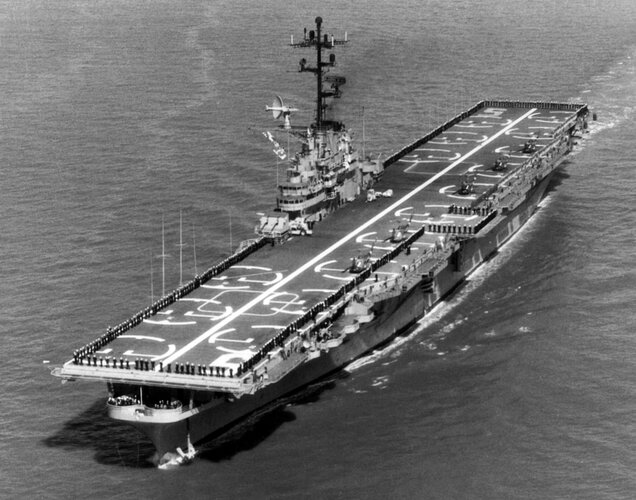
SSgtC
ACCESS: Top Secret
- Joined
- 13 July 2020
- Messages
- 1,240
- Reaction score
- 2,877
The problem with doing that, is that just sticks you with a far less capable carrier than an SCB-27C/125 Essex for the exact same operational costs. The Navy itself had zero interest in operating Harriers. For several reasons. As @Archibald pointed out, the AV-8A kinda sucked. The Navy's existing strike planes were far more capable than early Harriers.I'd like to imagine if the Essex without angled deck had been used as Harrier carrier/SCS or Marines' support carrier.
The Essex that could have become this are :
USS Franklin (CV-13) in reserve until July 1966,
USS Tarawa (CV-40) in reserve until October 1968,
USS Leyte (CV-32) in reserve until September 1970,
USS Boxer (CV-21) in reserve until March 1971, as amphibious assault ship in 1958,
USS Valley Forge (CV-45) in reserve until October 1971, modified as amphibious assault ship in 1961,
USS Princeton (CV-37), in reserve until September 1972, as aphibious assault ship in 1959,
USS Bunker Hill (CV-17), in reserve until July 1973.
I think that with a mix of SCB-27/125, they would have been a good platform for a Harrier carrier/Sea Control Ship.
Keeping the Hurricane bow, but without the angled deck, and of course without the catapult or arresting wire.
Such a ship almost existed, since in the mid-70s, Spain considered buying the USS Lake Champlain (CV-39), and it would probably have become a Harrier carrier in the style of the Dédalo (R01).
View attachment 717613
On top of that, unlike most other Navies that had to make the somewhat bitter choice to abandon Cats & Traps carriers due their escalating cost and size, the USN had no such need. They had, during the 1960s, twenty-six angled deck carriers with the smallest being roughly 44,000 tons. Think about that, those were the small carriers in the Navy. The rest of the world was operating carriers that were half that tonnage. They had no need at all to try and go STOVL.
And finally, politics. The Navy desperately wanted more Super Carriers, and more Nimitz class in particular. Converting straight deck Essex class to operate Harriers gives congress an easy way to kill the Nimitz class, something they tried to do several times. Why give them an even easier time of it?
BlackBat242
OK, I changed my personal text ;)
- Joined
- 10 April 2013
- Messages
- 1,447
- Reaction score
- 4,146
And finally, politics. The Navy desperately wanted more Super Carriers, and more Nimitz class in particular. Converting straight deck Essex class to operate Harriers gives congress an easy way to kill the Nimitz class, something they tried to do several times. Why give them an even easier time of it?
Which is why FDR was scrapped so quickly - the USN was afraid Carter would order her modernized instead of authorizing CVN-71 Theodore Roosevelt.
Initially, President Gerald Ford cancelled the order for CVN-71 in 1976 and substituted two CVV-type carriers that were expected to operate V/STOL aircraft. The existing T-CBL design formed the basis for the new CVV, serving as a replacement for the aging Midway-class carriers, while capable of operating all existing conventional carrier aircraft. In any case, construction of the proposed CVV medium-sized carrier never took place.
Authorization for CVN-71 was further delayed when President Jimmy Carter vetoed the 1979 Fiscal Year Department of Defense authorization bill because of the inclusion of this Nimitz-class nuclear supercarrier in the Navy ship-building program.
As a result of the Iran hostage crisis, President Carter reversed his stand on Nimitz-class nuclear supercarriers, and CVN-71 was subsequently authorized under the 1980 Fiscal Year authorization bill for the U.S. Department of Defense.
If FDR was sitting quietly in reserve, it would be very possible that she would be modernized and TR pushed back even further.
Any updates on the way?
alejandrogrossi
ACCESS: Secret
- Joined
- 20 September 2019
- Messages
- 266
- Reaction score
- 443
Scott Kenny
ACCESS: USAP
- Joined
- 15 May 2023
- Messages
- 11,205
- Reaction score
- 13,573
Pardon me, binged the thread.
And the US wasn't using anything but S5Ws in subs until the 1970s. Los Angeles class boats used S6G.
Considering that the US is among those screwed by the CIA...What country among the present 191 on this planet, wasn't screwed by the CIA at some point in history ? the list must not be very long...
That's probably the ideal "buying a foreign aircraft fleet" option.Maybe not the whole aircraft, but perhaps an arrangement similar to the one with Dassault where items that will wear out and require regular replacement are locally built, with the rest sent to Australia in kit form for final assembly? So things like engines, hydraulics, landing gear, flaps, elevators, some of the avionics. Might be a better deal than buying completed aircraft. It keeps workers in both countries busy and let's the RAAF have a secure supply of spare parts going forward.
Oh, man, just missed ace-in-a-day!November 6, 1957
Sulawesi, Indonesia
Loyal units of the Indonesian Army launch an attack on the Permesta rebels with heavy support provided by the Indonesian Air Force flying B-25 Mitchel and Ilyushin Il-28 bombers, P-51 Mustang and MiG-17 fighters. In a coordinated assault, the Army rolls over the main Permesta base, scattering the rebels into the jungle.
In the sky above Sulawesi, the first Indonesian pilots to take the Shenyang F-5 into battle engage the CIA supplied rebel P-47s and A-20s. It is a slaughter as the WWII veteran airframes are bounced by the far superior Chinese supplied aircraft. In one notable example, Captain Saleh Basarah shot down three P-47s and one A-20 on a single mission. He was the first Indonesian pilot to convert to jet aircraft and the first to qualify on the F-5. He also became the first Indonesian Air Force Officer to score an air-to-air kill. Though Indonesia was still in the process of standing up their F-5 force, the decision had been made to commit those pilots and aircraft deemed ready for operations by their training officers as a display of strength and resolve.
I don't think the A4Ws have any more uranium in them, actually. Where this gets ugly is the reactor vessels and pumps.Sixteen nuclear reactors... for two ships. Guess why they waited for another decade for Nimitz... OTL.
Well, those are 35khp reactors, and that's honestly a lot more horsepower than most of the subs need. S5W is only a 15khp design, the S6G is roughly 30-35khp.If you can get the A2W related powerplant to standardize your nuclear surface fleet for a generation with a C2W variant, and go ahead with the S2W variant for the submarine fleet, you might be able to leverage the numbers into a savings of sorts.
Two A2W driving a shaft for surface combatants would be the same powerplant as the BigE. You could have perfectly uniform training and maintenance. The same second generation Westinghouse core for the sub fleet means substantial overlap there.
All the cores would have standardized yard procedures for refueling which if there's only one or two dedicated yards on each coast means you're not constantly re-training and setting up to accommodate ad hoc.
You'd have to weigh outlay costs against the lessened fleet reliance on oilers and operational advantages. The negative on a substantial nuclear fleet is obviously high acquisition and maintenance costs. But if you can offset some of this with a bulk buy of standardized reactor cores maybe there is some cost-benefit discussion to be had. Since you're "stuck" with two Enterprise -class carriers and 16 second generation Westinghouse cores (plus spares), maybe you try to make the most of it.
And the US wasn't using anything but S5Ws in subs until the 1970s. Los Angeles class boats used S6G.
Unguided rockets are basically 70mm cannon that don't beat your airframe up like a cannon does.I have always thought unguided rockets were a strange concept, a heavy cannon armament (such as the Hunters Adens) would be much more effective.
So you have Dulles involved in an unfortunate fatal car crash.Let's just say that if he could, Eisenhower would fire Dulles yesterday. But firing him would be seen as confirmation that the US was involved and Dulles was the sacrificial lamb.
You laugh because otherwise you start screaming.That was a lame / bad joke, admittedly. Lot of people died that day...
If the RN isn't fielding both carriers, they could push "both" air wings onto one ship.No argument here. Just wanted to point out that, for her size, she was planned to have an extremely small air wing. 50 total aircraft, with only 36 usable for strike or A2A roles. For the era when she would be entering service, she would be significantly under-armed in terms of air wing.
I'm assuming that the small size of the air wing was done intentionally for two reasons: first, save money on not having to buy an extra 30+ aircraft for the two carriers. And second, that the FAA assumed aircraft sizes would continue to grow and CVA-01 would have the space to board the next generation of aircraft and still keep 50 planes in her air wing.
Just going to say that as a submariner, that crew is Presidential Unit Citation material, or whatever the Dutch top unit award is. Absolutely awesome work getting 3 high-value LSTs and a DD (via down the throat shot, no less!)An excellent sub driver and top notch crew vs a Navy that might charitably be called "the third string."
- Joined
- 6 November 2010
- Messages
- 5,226
- Reaction score
- 5,433
Militaire Willems-Orde, usually awarded to individuals.Presidential Unit Citation material, or whatever the Dutch top unit award is.
Two notable exceptions:
- Belatedly awarded in 2006 to 1st (Polish) Independent Parachute Brigade for acts of bravery, skill and devotion during Operation Market Garden in 1944
- Awarded in 2016 to Korps Commandotroepen for its service in Afghanistan
BlackBat242
OK, I changed my personal text ;)
- Joined
- 10 April 2013
- Messages
- 1,447
- Reaction score
- 4,146
Coral Sea operated F/A-18As and E-2Cs - and the main difference was in the flight deck shape/area and the location of the port aircraft elevator. FDR's hangar, just like CS & Midway's, was 17'6" clear height - and E-2s fit in them just fine (E-2B/Cs were 18 ft 3+3⁄4 in (5.582 m) in height, but the radome could retract by 2 feet (0.6 m) to fit into the 17 ft 6 in (5.33 m) clear height hangar of Essex and Midway class carriers).BlackBat242
With her austere overhull, could be possible to the USS FDR, operate an F/A-18 or E-2C.
I known that with last refit, operated A-6 , A-7 and F-4
View attachment 730825
FDR's "austere overhaul" fitted not only new stronger arresting gear and moved the forward aircraft elevator to deck-edge, but stronger catapults (2xC13s) as well - while CS still had 3xC11s.
So yes, she could have operated Hornets & Hawkeyes as soon as the appropriate aircraft maintenance/repair equipment were installed.
Such a decision to extend her operational life would at least result in adding an extension of the flight deck on the aft port quarter to provide more deck park space, even if the port elevator wasn't moved aft to match CS.
E-2C with radome up (note the panels on the radome support - as well as airframe distortion on landing shown by the ripples in the skin):
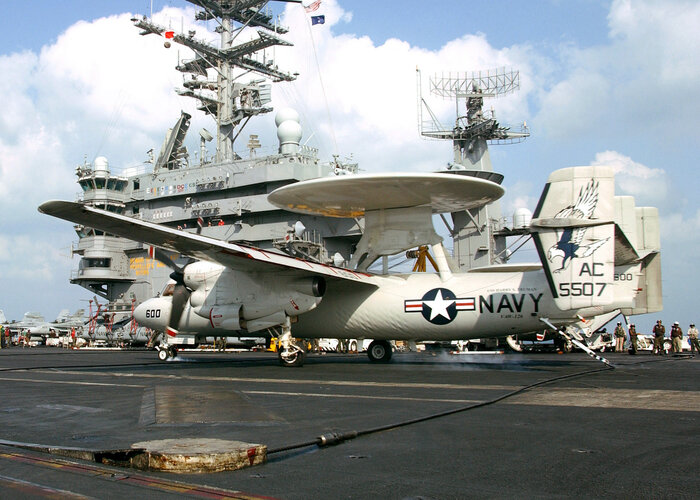
An E-2C with the radome lowered - note the panels on the support folded outwards:
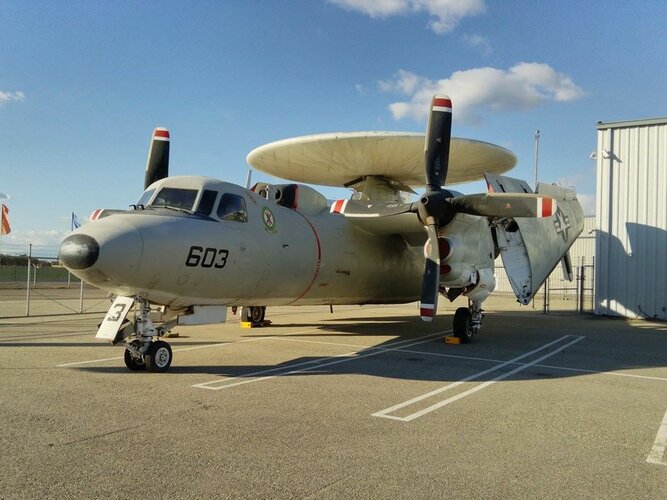
Last edited:
A case could be made that Coral Sea ended as the happiest of the three. FDR life was cut short by its peculiar turbines, as for Midway, they went waaaaay too far with the last rebuild. In a sense, it was as botched as HMS Victorious. And equally eye watering expensive.
SSgtC
ACCESS: Top Secret
- Joined
- 13 July 2020
- Messages
- 1,240
- Reaction score
- 2,877
From everything I've seen, there was nothing wrong with the engineering plant on the FDR. And the Navy still had tons of spare parts laying around for her GE Turbines. But the Navy used it as a convenient excuse to scrap her and get Congress to pay for another Nimitz.A case could be made that Coral Sea ended as the happiest of the three. FDR life was cut short by its peculiar turbines, as for Midway, they went waaaaay too far with the last rebuild. In a sense, it was as botched as HMS Victorious. And equally eye watering expensive.
CV12Hornet
ACCESS: Top Secret
- Joined
- 8 January 2021
- Messages
- 505
- Reaction score
- 1,139
Eh, Victorious and Midway were botched in very different ways. Victorious was botched because it took way too long, cost way too much, all for a ship way too small and incapable. Midway was botched because the ship was genuinely unsafe afterward.A case could be made that Coral Sea ended as the happiest of the three. FDR life was cut short by its peculiar turbines, as for Midway, they went waaaaay too far with the last rebuild. In a sense, it was as botched as HMS Victorious. And equally eye watering expensive.
SSgtC
ACCESS: Top Secret
- Joined
- 13 July 2020
- Messages
- 1,240
- Reaction score
- 2,877
Wasn't part of the issue with Victorious that they needed to reboiler her in order to operate the steam cats, but no one realized it until they were only a few months away from being done, then they had to rip everything apart again and start all over?Eh, Victorious and Midway were botched in very different ways. Victorious was botched because it took way too long, cost way too much, all for a ship way too small and incapable. Midway was botched because the ship was genuinely unsafe afterward.
CV12Hornet
ACCESS: Top Secret
- Joined
- 8 January 2021
- Messages
- 505
- Reaction score
- 1,139
Correct on all counts, though her electrical needs and general machinery age were issues as well that contributed to the decision.Wasn't part of the issue with Victorious that they needed to reboiler her in order to operate the steam cats, but no one realized it until they were only a few months away from being done, then they had to rip everything apart again and start all over?
alejandrogrossi
ACCESS: Secret
- Joined
- 20 September 2019
- Messages
- 266
- Reaction score
- 443
BlackBat242Coral Sea operated F/A-18As and E-2Cs - and the main difference was in the flight deck shape/area and the location of the port aircraft elevator. FDR's hangar, just like CS & Midway's, was 17'6" clear height - and E-2s fit in them just fine (E-2B/Cs were 18 ft 3+3⁄4 in (5.582 m) in height, but the radome could retract by 2 feet (0.6 m) to fit into the 17 ft 6 in (5.33 m) clear height hangar of Essex and Midway class carriers).
FDR's "austere overhaul" fitted not only new stronger arresting gear and moved the forward aircraft elevator to deck-edge, but stronger catapults (2xC13s) as well - while CS still had 3xC11s.
So yes, she could have operated Hornets & Hawkeyes as soon as the appropriate aircraft maintenance/repair equipment were installed.
Such a decision to extend her operational life would at least result in adding an extension of the flight deck on the aft port quarter to provide more deck park space, even if the port elevator wasn't moved aft to match CS.
E-2C with radome up (note the panels on the radome support - as well as airframe distortion on landing shown by the ripples in the skin):
View attachment 732281
An E-2C with the radome lowered - note the panels on the support folded outwards:
View attachment 732282
First
Thank you for your complete answer.
Second
My doubt was about that I never saw a picture of a E-2 landing on CV-42, even on an exercise. I thought it could be due to the length of the angle deck.
But then I saw the 2 pictures at the end, and my doubts regarding the E-2 changed
Great data about cats, I didn't known
I was already clear that the hangar have the same size of the Cv-43.
Again thanks for all
PD: pictures are form the CV-42 page
Attachments
Scott Kenny
ACCESS: USAP
- Joined
- 15 May 2023
- Messages
- 11,205
- Reaction score
- 13,573
Coral Sea's flight deck is definitely my preferred "midsize carrier" setup. Though any new construction should have catapults equivalent to C-13s, not C-11s.A case could be made that Coral Sea ended as the happiest of the three. FDR life was cut short by its peculiar turbines, as for Midway, they went waaaaay too far with the last rebuild. In a sense, it was as botched as HMS Victorious. And equally eye watering expensive.
Rule of cool
ACCESS: Top Secret
- Joined
- 16 January 2024
- Messages
- 1,840
- Reaction score
- 2,473
The Coral Sea got the final version of the SCB110 modernisation {SCB110A), complete with 3 well placed deck edge lifts and 3 full length C11 catapults. As opposed to Midway and FDR 's partial and poorly placed deck edge lifts, and a short C11 waist cat as well as the 2 long C11s on the bow.
This is why Midway got it's nightmarish SCB101 rebuild, with 2 C13s and the deck layout that made her list. The FDR basically had her short waist C11 cat removed and the lifts rearranged as a result of Midway's problems. A far better course of action would have been to bring Midway and FDR up to Coral Sea's spec, maybe with some easy improvements., this would have gotten both carriers updated to a good spec for the same cost.
Carrier development in this period is as interesting as fighter development at the same time! So many options and paths not taken.
This is why Midway got it's nightmarish SCB101 rebuild, with 2 C13s and the deck layout that made her list. The FDR basically had her short waist C11 cat removed and the lifts rearranged as a result of Midway's problems. A far better course of action would have been to bring Midway and FDR up to Coral Sea's spec, maybe with some easy improvements., this would have gotten both carriers updated to a good spec for the same cost.
Carrier development in this period is as interesting as fighter development at the same time! So many options and paths not taken.
BlackBat242
OK, I changed my personal text ;)
- Joined
- 10 April 2013
- Messages
- 1,447
- Reaction score
- 4,146
FDR was planned for the same modernization as Midway... the true cause of the "austere overhaul" instead of full modernization for FDR was indeed Midway's screwed-up modernization.A case could be made that Coral Sea ended as the happiest of the three. FDR life was cut short by its peculiar turbines, as for Midway, they went waaaaay too far with the last rebuild. In a sense, it was as botched as HMS Victorious. And equally eye watering expensive.
From everything I've seen, there was nothing wrong with the engineering plant on the FDR. And the Navy still had tons of spare parts laying around for her GE Turbines. But the Navy used it as a convenient excuse to scrap her and get Congress to pay for another Nimitz.
That took too long, and cost too much (the cost rose from a planned $87 million to $202 million.) - even before she was refloated and the freeboard/stability issues became known, FDR's full mod. was cancelled on cost grounds.
Midway's SCB 101.66 modernization took from February 1966 to March 1970.http://navysite.de/cruisebooks/cv41-85/009.htm
FDR's SCB-103.68 "austere overhaul" was done between July 1968 and May 1969 - starting right when her SCB-101.68 "Midway-style" modernization was supposed to begin.
Had the USN accepted early on that none of the Midway class would be able to operate their new "Fleet Defense Fighter" - whether F-111B or VFX (Grumman's design wasn't chosen until January 1969) - then Midway could (and likely would) have been given a less-ambitious Coral Sea-like modernization that would have cost less and finished sooner.
This would have allowed FDR to follow suit, with the combined modernizations fitting within the historic costs of both SCB-101.66 and SCB-103.68.
Rule of cool
ACCESS: Top Secret
- Joined
- 16 January 2024
- Messages
- 1,840
- Reaction score
- 2,473
Had the USN accepted early on that none of the Midway class would be able to operate their new "Fleet Defense Fighter" - whether F-111B or VFX (Grumman's design wasn't chosen until January 1969) - then Midway could (and likely would) have been given a less-ambitious Coral Sea-like modernization that would have cost less and finished sooner.
That's a monumental decision. What was the status of the VFAX at the time? Would a carrier with VFAX be seen as a dud?
BlackBat242
OK, I changed my personal text ;)
- Joined
- 10 April 2013
- Messages
- 1,447
- Reaction score
- 4,146
At the time Midway started her SB-101.66 the F-111B had not yet been cancelled, so VFX hadn't even been started.That's a monumental decision. What was the status of the VFAX at the time? Would a carrier with VFAX be seen as a dud?
When FDR started her SCB-103.68 the F-111B had been cancelled, but the RFP for VFX was only issued in July - the same month work began on FDR.
So it would have taken an earlier assessment of the F-111B as "too big & heavy for the Midways".
VFAX was originally for a low-cost complement to the F-111B (to replace the only F-4 Phantom, as the A-7 was just entering production), but with the USN not liking the F-111B it grew in size and complexity - eventually being redefined to the VFX specification that produced the F-14.
No RFP for VFAX was ever issued before the program shifted to an F-111B replacement.
VFAX was revived in the 1970s for a F-4 Phantom and A-7 Corsair replacement, but that is out of the scope of something the Midway class modernizations could be planned around.
Last edited:
A far better course of action would have been to bring Midway and FDR up to Coral Sea's spec, maybe with some easy improvements., this would have gotten both carriers updated to a good spec for the same cost.
Spot on. And you know what ? Coral Sea would have become the "template" for "best reasonable upgrade of Midway class" . Very much like SCB-125 became Essex best bang-for-the-buck modernization effort. Homogenous, and good enough to the end of their careers.
(Btw, why was SCB-125 limited to 15 - or 16 - Essex when a few more hulls were available ? how about pushing the upgrade number to 20 ?)
Similar threads
-
Royal Navy got Essex carriers - with a twist.
- Started by Archibald
- Replies: 51
-
Royal Navy Type 82 Alternatives and comparisons with other navies
- Started by uk 75
- Replies: 20
-
Sukarno stays in power - what would Australia do?
- Started by Dilandu
- Replies: 538
-
1980's 600 Ship Navy Essex Class Reactivation Plan
- Started by Ironmiked
- Replies: 32
-
Anson-class missile battleships (RN)
- Started by Dilandu
- Replies: 18

